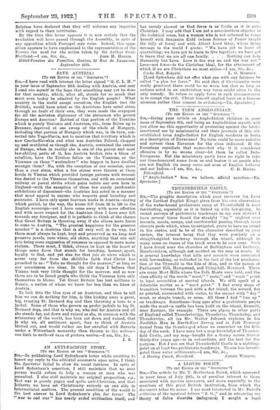THUNDERFIELD CASTLE. [To THE EDITOR OF THE "SPECTATOR."] Suz, — The graphic
description which your reviewer (on Laws of the Earliest English Kings) gives from his own observation
of the water-bound prehistoric: camp at Thunderfield is most fascinating, especially as it is linked up with law-giving. In recent surveys of prehistoric trackways in my own district I have several times found the straight " ley " (sighted over mounds, moats, camps, and earthworks) passing through largo obscure pools which, when investigated, prove to have an island in the centre, and to be of the character described in your review, the interest being that they were precisely on a straight-sighted trackway through the island, although in many cases no traces of the track were to be seen near. Such I have found near the churches at Bullingham and Ledbury, Herefordshire, although not marked on the map as moats. It is general knowledge that hills and mounds were associated with law-making, as indicated in the fact of the law proclama- tion at the Tynwald in the Isle of Man, and in the names of Parliament Hill, Hampstead, and Thing-hill, Hereford. There are many Moot Hills where the Polk Moots were held, and the close affinity of the words "moot," "mote," and " moat " point to legal assemblies at moa.ted islands. We still speak of a debatable matter as a "moot point." I find every stage of transition between the pool with a flat island, the mound, flat or pointed, surrounded with water, to the mound with " dry " moat, or simple trench, or none. All these I find "lino up" on trackways. Sometimes—long ages after a prehistoric people made the moat—a castle has been built on the island, Bronsill, near Eastnor, for example. There are places in other parts of England called Thunderbridge, Thunderby, Thunderley, and Thunderidge, all (as Mr. Walter Johnson explains in his
Neolithic Man in North-East Surrey and in Folk Memory) named from the thunder-god whom we remember on the fifth
day of the week. I have none but a map knowledge of Thunder- field Castle, and my map—bought for a tramp across Surrey thirty-five years ago—is in cut-sections, not the best for the purpose. But I can see that Thunderfield Castle is a sighting. point on at least two prehistoric trackways. No one has investi- gated these water settlements.—I am, Sir, &c.,


































 Previous page
Previous page